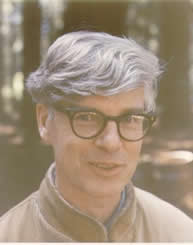

|

|
IN MEMORIAM
Paul Emery Thomas
Professor of Mathematics, Emeritus
Berkeley
1927 — 2005
Paul Emery Thomas (known to everyone as Emery) was born on 15 February 1927 in Phoenix, Arizona. His father had been born in North Dakota, and his mother in South Dakota. The family returned to North Dakota, where Emery graduated from Central High School in Fargo, North Dakota, in 1945. He served a year in the Navy, repairing radar sets in Monterey, before entering Oberlin College in 1946. Emery graduated with a baccalaureate degree in mathematics in 1950. He sang in the Oberlin Conservatory chorus, and spent summers working in Estes Park, Colorado.
Next came a Rhodes Scholarship to Oxford University (Hertford College), where he earned a first class degree and an M.A. At Oxford, Emery developed a strong interest in algebraic topology under the influence of J. H. C. Whitehead and initiated a long time friendship and collaboration with Ioan James. Returning to the U.S. in 1953, he entered graduate school at Princeton University and quickly completed his doctoral degree under Norman Steenrod in 1955. His dissertation, "A Generalization of the Pontrjagin Square Cohomology Operation," was a significant piece of work that introduced new cohomology operations. An announcement of it was published in the Proceedings of the National Academy of Sciences, and the full version appeared in 1958 as a Memoir of the American Mathematical Society.
After obtaining his degree Emery served as a research associate at Columbia University for the 1955-56 academic year, and then he was appointed as an assistant professor at the University of California, Berkeley, starting in 1956. His work branched out into other areas of topology, including characteristic classes, fiber bundles, the structure of classifying spaces, and vector fields on manifolds. Emery married Jean Chan, a potter and teacher, in 1958, and they spent their first year together at Oxford. Back at Berkeley, he won rapid promotion, first to associate professor in 1960, and then to full professor in 1963.
Emery's work further broadened to include problems of obstructions to smoothing singularities and embedding problems, but cohomology theory (including cohomology operations) remained a central tool in his work. Although he began his career as a topologist, he became interested in number theory and algebraic geometry by the late 1970s. He studied Hilbert modular varieties and related arithmetic questions about real cubic fields. Emery carried out a research program centered around these ideas, often in collaboration with A. T. Vasquez of the City University of New York.
After his work on Hilbert modular varieties was completed, Emery realized that he had been transformed into a number theorist! From 1990 on, his published articles fall squarely into number theory, and several of them treat questions involving Diophantine equations. His last published article, published in 2000, deals with subtle questions about the number of solutions of certain equations that had been studied previously by some of the giants of twentieth century arithmetic. The review of the article, written by the Strasbourg number theorist Yann Bugeaud, concludes as follows: "I would like to point out that this paper is written in a very clear and readable style. Moreover, it contains several important new ideas, which will certainly have further applications."
Emery supervised the doctoral work of 31 students, many of whom also had successful careers in mathematics. He served as vice chair of the Department of Mathematics and also as the de facto chair in 1967 during a difficult time when the dean and department could not agree on a chair. Emery became chair in 1972-73 and led the Department of Mathematics in designing a system of electing the chair which has worked well ever since.
Emery was a Guggenheim Fellow at the Institute for Advanced Study in 1961. He was a Miller Professor in 1966-67, and then served on the executive committee of the Miller Institute during 1983-89 and was executive director from July 1987 through June 1989. He was a trustee of the American Mathematics Society during 1980-85 and served on numerous committees of the AMS. He was also deputy director of the Mathematical Sciences Research Institute from 1987 to 1990.
Emery was the first real topologist to come to Berkeley, so he was a pioneer in that sense. He was a warm, good-natured person—cheerful and public-spirited. One always felt uplifted after talking to him. He was a valued citizen of the department and the campus. He retired in 1991 under the University's Voluntary Early Retirement Program but remained active in research. His last mathematics paper was finished in 2003 and in galley proofs when he died 13 June 2005, of complications of Parkinson's disease.
Emery is survived by his wife of 47 years, Jean, daughters Jenny Thomas of Hercules, California, and Valerie Thomas of Montclair, New Jersey, and two grandchildren.
Robion C. Kirby
Calvin C. Moore
Kenneth Ribet